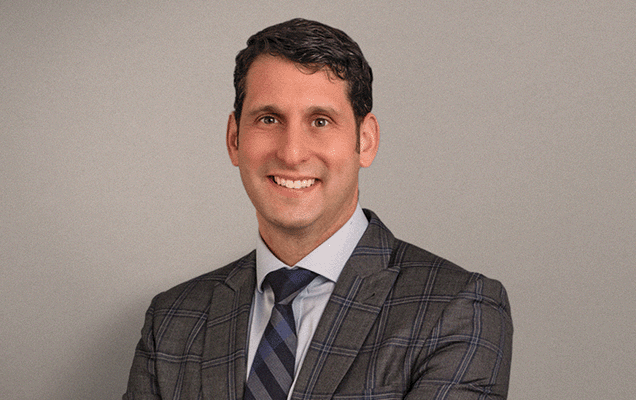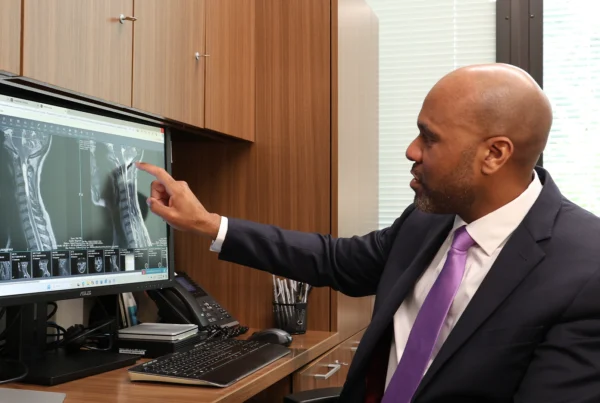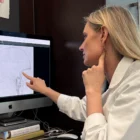Cervical spondylosis without myelopathy is a degenerative condition of the cervical spine that can often be treated without surgery. In some cases, patients who have exhausted conservative management may benefit from surgery.
What is Cervical Spondylosis Without Myelopathy
Cervical spondylosis without myelopathy is a condition where wear and tear accumulate in your neck, without putting pressure on the spinal cord.
The spine is a column of bones called vertebrae, which support your body. In between the vertebrae are spongy tissues called discs. The discs act to cushion your spine. There are also joints in the back of your neck called facet joints. The discs and joints bend and flex to provide motion to your spine.
Nearly all Americans will experience neck pain at some point in their lives.
As we get older, we accumulate wear and tear on our bodies, which leads to degeneration, or breaking down, of those discs. This can eventually cause them to bulge or herniate. It can also lead to bone spurs around the joints of the spine.
The Intervertebral disc is a layer of cartilage that separates the adjacent vertebrae in the spine. There are various medical conditions that can make someone more prone to developing degenerative disc disease. This condition is called cervical spondylosis. This accumulation of wear and tear can cause pain and stiffness in the neck as well as a loss of range of motion. Your lumbar spine, or lower back, can also manifest similar changes leading to pain and dysfunction.
What is Cervical Spondylosis?
Cervical spondylosis can lead to severe neck pain. It can also lead to compression of the spinal cord and nerve roots that run within your spinal canal.
The spinal cord runs down a channel in your neck called the spinal canal. The spinal cord and nerve roots are located behind your discs. When a disc bulges or herniates, it can press backward causing narrowing of the spinal canal. This condition is known as spinal stenosis.
In severe cases, spinal stenosis can lead to spinal cord compression. This can result in radiating arm pain, numbness, and tingling in the arms, as well as clumsiness in the hands and feet. Compression of the spinal cord with these resulting symptoms is called cervical myelopathy. This condition can be serious and lead to progressive neurologic damage and is often treated surgically to remove the pressure on the spinal cord and nerves.
How Do We Treat Cervical Spondylosis Without Myelopathy?
Cases of cervical spondylosis without myelopathy or nerve compression are generally less serious and can often be treated without surgery.
Treatment options that do not involve surgery include anti-inflammatory medications and physical therapy. Alternative medicine options such as chiropractic care, acupuncture, and massage therapy can also be helpful. Some patients also benefit from injections administered by an interventional pain management specialist. A combination of these treatments can often successfully relieve pain and get patients back to their active function.
Do You Need This Condition Further Explained?
In some refractory cases where a patient does not respond to an extensive course of conservative management, surgery can be successful at relieving pain.
In some cases, removing the collapsed and painful disc and replacing it with a cage (spinal fusion) or an implant (disc replacement) can be very effective at relieving pain and restoring function.
Are you suffering from cervical spondylosis without myelopathy? Call for an appointment at, 551-284-3265, with one of our spine specialists today. We are looking forward to hearing your story, and providing you with all of the necessary information for a great patient experience.

About Dr. Seth Grossman
Dr. Seth Grossman is a board-certified, fellowship-trained orthopaedic spine surgeon. He has been involved in clinical research throughout his medical training and has been published in several peer-reviewed journals. Dr. Grossman prides himself on first exhausting all non-surgical treatment options. When surgery is necessary, he employs surgical techniques that will achieve the best results for his patients while causing the least amount of pain and allowing the fastest recovery possible. He is passionate about combining medicine and technology. He specializes in robotically assisted spine surgery, disc replacement surgery, and minimally invasive techniques for both spinal decompression and spinal fusion surgery.
Please call today to schedule a consultation with me.
(551)284-3265
Request a consultation with Dr. Grossman






